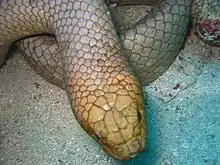Aipysurus
Aipysurus[n 1] is a genus of venomous snakes in the subfamily Hydrophiinae of the family Elapidae. Member species of the genus are found in warm seas from the Indian Ocean to the Pacific Ocean.
| Aipysurus | |
|---|---|
 | |
| Aipysurus laevis | |
| Scientific classification | |
| Domain: | Eukaryota |
| Kingdom: | Animalia |
| Phylum: | Chordata |
| Class: | Reptilia |
| Order: | Squamata |
| Suborder: | Serpentes |
| Family: | Elapidae |
| Subfamily: | Hydrophiinae |
| Genus: | Aipysurus Lacépède, 1804[1] |
Taxonomy
The first description of the genus Aipysurus was published by Bernard Germain de Lacépède in 1804, accommodating his description of a new species found in Australian seas, Aipysurus laevis, the type species of the genus. The description was accompanied by an illustration of the new species.[1] The genus is one of a small group of the viviparous sea snakes (Hydrophiinae: Hydrophiini) with Emydocephalus, also mostly restricted to the seas between Timor, New Guinea and northern Australia.[4]
The following is a list of species.[5]
| Image | Species | Authority | Common name | Geographic range |
|---|---|---|---|---|
| Aipysurus apraefrontalis | M.A. Smith, 1926 | Short-nosed sea snake | Western Australia | |
| Aipysurus duboisii | Bavay, 1869 | Reef shallows sea snake; Dubois' sea snake | coastal areas of Australia | |
 |
Aipysurus eydouxii | (Gray, 1849) | Spine-tailed sea snake; Marbled sea snake; Beaded sea snake | Western Australia, Northern Territory, Queensland, the South China Sea, the Gulf of Thailand, Indonesia, Peninsular Malaysia, Vietnam and New Guinea |
| Aipysurus foliosquama | M.A. Smith, 1926 | Leaf-scaled sea snake | Ashmore and Cartier Islands | |
| Aipysurus fuscus | (Tschudi, 1837) | Dusky sea snake | Timor Sea between Australia, Indonesia and East Timor | |
 |
Aipysurus laevis | Lacépède, 1804 | Olive-brown sea snake; Olive sea snake | Great Barrier Reef |
| Aipysurus mosaicus | Sanders et al., 2012[4] | Mosaic sea snake | Northern Australia and New Guinea | |
| Aipysurus tenuis | Lönnberg & Andersson, 1913 | Arafura sea snake | Western Australia, from near Dampier to Broome, and in the Arafura Sea | |
Nota bene: A binomial authority in parentheses indicates that the species was originally described in a genus other than Aipysurus.
A subspecies nominated in 1974 as A. laevis pooleorum was elevated in 1983 to full species status, as A. pooleorum, without explanation by the authors. The same revision (Wells and Wellington, 1983) also resurrected the species name Aipysurus jukesii (Gray, 1846), recognised as a synonym of Lacépède's Aipysurus laevis. [4]
Notes
References
- Lacépède BG (1804). "Mémoire sur plusieurs animaux de la Nouvelle-Hollande dont la description n'a pas encore été publiée". Annales du Muséum d'histoire naturelle. 4: 184-211 [210, pl. 56]. (in French).
- αἰπύς, οὐρά. Liddell, Henry George; Scott, Robert; A Greek–English Lexicon at the Perseus Project.
- "The Sea Snakes of Australia". Australian Biodiversity Record. 8 (1–124): 7. 2007. ISSN 1325-2992.
- Sanders KL; et al. (2012). "Aipysurus mosaicus, a new species of egg-eating sea snake (Elapidae: Hydrophiinae), with a redescription of Aipysurus eydouxii (Gray, 1849)". Zootaxa. 3431: 1–18. doi:10.11646/zootaxa.3431.1.1.
- "Aipysurus ". Integrated Taxonomic Information System. Retrieved 20 September 2007.
Further reading
- Boulenger, George Albert (1896). Catalogue of the Snakes in the British Museum (Natural History). Volume III., Containing the Colubridæ (Opisthoglyphæ and Proteroglyphæ) ... London: Trustees of the British Museum (Natural History). (Taylor and Francis, printers). xiv + 727 pp. + Plates I-XXV. (Genus Aipysurus, p. 303).
- Goin, Coleman J.; Goin, Olive B.; Zug, George R. (1978). Introduction to Herpetology, Third Edition. San Francisco: W.H. Freeman and Company. xi + 378 pp. ISBN 0-7167-0020-4. (Aipysurus, p. 332).